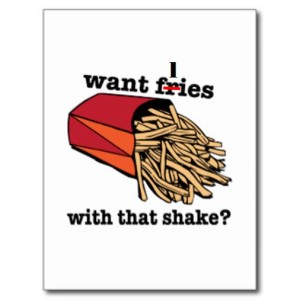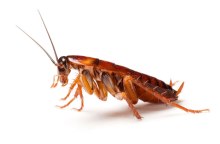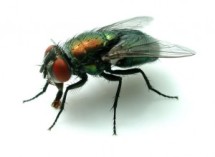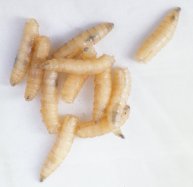Well, not actually you, but rather your dog.
Before food purists get up in arms over this topic, consider that numerous human cultures have historically viewed insects as acceptable and even highly desirable food items. And today, our ever-expanding human population and the increasing need for sustainable sources of food have led to increased consideration of insects as food in almost all human cultures.
So, it’s not much of a jump to ask – what might this mean for feeding dogs?
It’s all about the protein: Protein is the most expensive nutrient in the diet of all animals, including humans. It is expensive both in terms of the monetary cost of its production and its ecological impact upon the environment. In the spirit of sustainability (a buzzword that pet food companies and other corporations love to trot out) and with the goal of reduced production costs (i.e. making foods more cheaply), pet nutritionists at The Nutro Company recently identified a number of potential alternative protein ingredients for dog and cat foods. Bugs, being plentiful, cheap, and protein-replete are included on that list.
And protein is all about amino acids: Although we talk about a dog’s protein requirement and about a food’s protein level or quality, the actual requirement that dogs and all animals have is for the essential amino acids (the building blocks of the dietary protein) and the nitrogen that dietary protein supplies. The reason that the parlance of nutrition centers on dietary protein is simply because foods contain protein, not individual amino acids. It is during the process of digestion that a food’s protein is broken down in the small intestine into its component amino acids, which are then absorbed into the body. So, at the level of an animal’s metabolic needs, it is the amino acids that actually count. This is why one of the first steps that nutritionists take when examining a potential protein-containing ingredient is to examine its amino acid composition.
So, can insect protein supply all of the essential amino acids that dogs require? The nutritionists at Nutro and at the University of California at Davis decided to find out (1).
The Study: A wide variety of different plant, algae and insect species were identified as potential alternative (and sustainable) protein sources for pet foods. Within the group of insects, the researchers focused on the adult and larval forms of various species of flies, cockroaches, and ants.
All of the bug samples were analyzed for total protein and amino acid content. (I will spare you the details regarding sample acquisition and preparation in case you are reading this during your lunch hour). Amino acid analysis included measurement of the 10 essential amino acids plus taurine, a special type of amino acid that is found primarily in animal tissues. Many readers are probably familiar with taurine as an essential dietary nutrient for cats. Because there is evidence that taurine may be needed during periods of physiological stress in some dogs, it has recently been classified as a “conditional essential amino acid” for dogs as well. Because sources of taurine are limited, it is an important essential nutrient to measure when considering new ingredients for dog and cat foods.
Results: Larval and adult forms of five different insect species were analysed. Here are their primary findings:
- High in protein: Total protein levels in all of the insect species were quite high. When reported on a dry matter basis, concentrations ranged between from 46 % in Black Soldier Fly larvae to 96 % in cockroaches. (Cockroaches? Who knew?).
- Bugs can do it: All but one species of insect (Black Soldier Fly larvae) were found to contain sufficient concentrations of protein, essential amino acids, and taurine to meet or exceed the NRC requirements for growth for dogs and cats. The finding for taurine was rather surprising because it has been previously assumed that rich sources of taurine included only skeletal muscle and organ meats.
- Ants and flies are best: Two groups of insects, ants and adult flesh flies, contained the most concentrated sources of taurine. However, these initial results suggest that all three of the groups that were studied – ants, cockroaches, and flies – may be nutritionally acceptable protein sources for dog and cat diets.
Take Away for Dog Folks
Dogs and cats (like humans) require nutrients in their diet, not ingredients. Therefore, if a particular protein ingredient can supply most or all of the dog’s essential amino acids, is nutritious when fed, and is safe and palatable, then it technically meets the criteria (ick factor aside) to be considered as a potential dietary ingredient. Having passed the first test of adequate protein and amino acid content, where do insects fall on these other criteria?
- Nutritious when fed: This refers to how digestible and bioavailable the essential nutrients of the ingredient actually are, when fed to the dog. For example, some insects and plants contain anti-nutritional factors, compounds that interfere with the ability to digest or use certain nutrients. Some of these compounds can be toxic or so potent as to cause illness, making their presence a clear “no-fly zone” for pets (pun intended).
- Safety: Many species of bugs have ways to protect themselves from becoming someone’s meal. They produce toxins that cause illness or consume plants whose by-products are toxic to animals. They may also just taste really, really nasty. Clearly, toxic bugs are out.
- Acceptability: Living with three dogs, one of whom is a notorious poop-eater, I would venture that the acceptability issue is as much about the human side of the equation than it is the dog side. Still, dogs must not just accept a bug-flavored food, they must relish it.
Will owners accept it? Might Cockroach Recipe for Seniors or Fly Formula for Active Dogs be a hard sell? My (gut) instinct is to say yes, especially in the US. We all project our own preferences and desires onto our dogs – it is our nature to do so. This is why dog foods that depict entire roasted chickens and sirloin steaks on their front panels sell so well (however misleading such graphics may actually be).
Still, seeing that there is a booming market for dog foods containing alligator meat, brushtail (Australian Possum), and Unagi (freshwater eel), along with treats made from dried bull penises, pig hooves and cow tracheas, one must admit that the bar is already set pretty low. Will insect dog food be next up?
Cited Study: McCuster S, Buff PR, Yu Z, Fascetti AJ. Amino acid content of selected plant, algae and insect species: A search for alternative protein sources for use in pet foods. Journal of Nutritional Science 2014;3:e39;1-5.








I’m gonna draw the line at tripe… As much as I love my dogs, giving them freshly chopped, still warm, green tripe is as far as this chick will go. I can’t imagine feeding them larvae or other weird looking insects!!!! I gag anytime I see either of them play and eat a house fly!! ((shudder))
LikeLiked by 1 person
Yeah…..I have to say that I agree, Renelle! 🙂
LikeLiked by 2 people
My threesome get their insects prey model. Grasshoppers are popular, and the really big ones they have here in Florida are easy to catch. Maggots make the compost heap all the more appealing. Small moths are so appealing that they justify battering in the window screens. Not to say the dogs are indiscriminate. Most caterpillars are BAD, as are cockroaches.
LikeLiked by 2 people
Hi Jen – Our Brittany, Vinny, decided that Tomato Hornwork Larvae were all the rage one year……and he would wait to “pluck” them until they were large and juicy……ick, ick, ick. (At least we had very healthy tomato plants that year!) 🙂
LikeLike
Digestibility is a huge issue with insects as a protein source. Most of the protein content as measured by the standard chemical methods is in the exoskeleton, locked up as chitin that mammals cannot digest. The poo of insectivorous mammals consists almost entirely of chitin bits that have gone all the way though.
LikeLiked by 2 people
Hi Peter – Thanks for your comment. This is true; my first research project in graduate school was to examine the merits of chitin (taken from the exoskeletons of shell fish, but the same stuff) as a diet ingredient for dogs. Even when cooked, it is highly unavailable as a protein source. I am not sure if anyone has looked at larval forms though. (The ick factor here is hard to shake, I must admit….. 🙂 ).
LikeLiked by 1 person
I’d rather feed my dog a bug-based kibble than one with chicken or lamb or beef and I guess there would be a good market for that if you see it from the “vegan” side. Yes, bugs are animals and they feel pain, but for me there is still a difference there.
LikeLiked by 1 person
HI Christine – This is a good point and one that has not yet been made yet, to my knowledge. I agree completely that the degree of suffering between animals who are raised for meat is very high, especially in concentrated animal feeding operations (CAFOs) that sadly are the norm in the US. Although they do have a nervous system, insects are invertebrates and some scholars in animal welfare and animal rights draw a distinction between the degree of suffering at the vertebrate/invertebrate level. While such a protein source could not technically be called vegan, it might be more acceptable to people who are trying to choose foods that overall cause less animal suffering. Thanks for the comment and for reading. Linda
LikeLiked by 1 person
Interesting, albeit shudder inducing, concept. I encourage my dogs to eat the “buggies” they find in the house. That way I don’t have to kill & dispose of them myself. And my 16 years young Lady has recently taken to chasing those little white/gray moths that fly up from the grass. BTW – which of your 4 darlings is the poop eater? Ginger was a notorious poop eater & Kaleb has taught Betty Sue the finer points of the sport too.
LikeLiked by 1 person
Hi Pam! (Missed you last night at open floor!!). Okay…..you have outed me……I shudder at saying this but……It is Ally!! Can you believe it? She started about a month ago and while she has a strongly trained “leave it”, the poop is just too enticing, it seems. Sigh…..All of the boys are simply appalled. We were hoping that because we did not have another poop eater when Ally joined our family, that we would be safe…..but no, she picked up the habit all on her very own….. (I laughed at the image of you sending in the Basenji continent to kill the bugs…. Lady to the rescue! 🙂 ).
LikeLiked by 1 person
Hahaha! Ally is such a character! I will definitely have to make it to the next open floor. 🙂
LikeLiked by 1 person
My dog will eat flies that she catches herself, but will not eat shrimp and will not eat the shellfish-based joint supplements. Some insects might not be accepted.
LikeLike
Pingback: Want Flies with that Shake? | Modern dog traini...
Encouraging cats and dogs to catch and eat their own insect prey may not be such a good idea – many parasites have insects as intermediate hosts.
LikeLike
Pingback: Want Flies with that Shake? | Protein Alternati...
Linda, great article. This is an area I have actively been researching and writing about. I have recently consulted for two start-up companies that are trying to market treats that are insect protein based, so the interest is there. I actually formulated some completely balanced homemade diets for cricket meal and dried meal worms for the groups. But as you and Peter point out, we desperately need some digestibility research. That is why I am exploring and recommending meal worms and other larval alternatives at the present time. Another area of concern for using insect protein based pet food is “the economy of scale” to produce and process large quantities of insects. Most operations are manual with limited production and the cost of the insects is high. Commercial operations will have to devise large, automated production facilities to drive protein costs down so I think large scale use of insect protein in pet food is not going to be in the cards soon. A daily homemade insect protein recipe for a 50lb. dog costs about $5- 6/day but is predicated on buying large quantities of dried meal worms at a time. So it is competitive with commercial canned premium products but far more expensive than dry kibbled products. On a personal note, to my surprise, my finicky Boston Bull Terrier “grand dog” likes my cricket recipe better than my homemade pork or chicken recipes.
LikeLiked by 1 person
Hi Ken
If you search the literature for work on insectivore (in the broad sense i.e. including ant eaters, aardwolves and aardvarks as well as small mongooses etc) energetics and metabolism I think that you will at least get a start on the digestability problem. It’s not my area of expertise but as far as I know specialist insectivores have low metabolic rates because their diet is actually not all that nutritious.
LikeLike
Hi Ken – Great to hear from you! I hope all is well. So interesting that you have consulted with companies that are developing insect treats and that you have done some formulation with cricket meal and meal worms. I was especially surprised at your information regarding economy of scale and the estimated cost of feeding! Who would have guessed! Love the palatability test with your grand-pup – an “n of 1” test anyway! Keep me posted about this when you can – would love to learn more. Best wishes, Linda
LikeLike
Cockroaches are definitely out!. One of our dogs once bit a cockroach — se spent several hours afterwards trying to get the taste out of her mouth. None of my other dogs as ever been silly enough to try cockroach 😦 Rats won’t touch them either!
LikeLike
Linda,
I’ve studied your book and others. I’ve recently been rotating dry foods that vary greatly in the percentage of crude protein. I know the DM basis is a more accurate representation of what it actually in the food. Is their a suggested amount of protein per day for dogs say in grams. I’m trying to make sure that I’m not over or under supplementing protein with treats or part of an egg. I know extra protein is excreted but it seems silly to feed extra calories for the protein if they are not needed. What is the best way to calculate all of this? Thanks
LikeLike
Pingback: Hearing Crickets? – The Science Dog
Pingback: Are There Benefits of Insect-Based Dog Foods? | The Science Dog